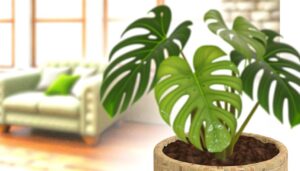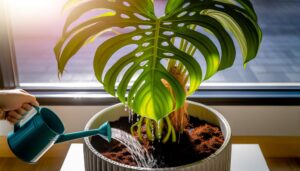Monstera Pinnatipartita Care Guide
For peak Monstera Pinnatipartita care, ensure bright, indirect light. Maintain temperatures between 65°F and 80°F, avoiding drops below 55°F.
Water when the top 2-3 inches of soil are dry, using a well-draining mix with perlite and organic matter. Keep humidity at 60-80%; a hygrometer helps.
Prune with sterilized tools and repot in a slightly larger pot for airflow. Inspect for pests like spider mites and aphids, treating with neem oil if needed.
Propagate via cuttings with nodes and aerial roots in a humid environment. Curious about detailed methods?

Key Takeaways
- Place in bright, indirect light and maintain temperatures between 65°F and 80°F.
- Water when the top 2-3 inches of soil are dry; use well-draining soil mix.
- Maintain humidity levels between 60% and 80% and ensure good air circulation.
- Prune yellow or damaged leaves with sterilized shears; repot in a breathable terracotta or ceramic pot.
- Inspect regularly for pests and treat infestations with insecticidal soap or neem oil.
Light Requirements
Monstera Pinnatipartita thrives best in bright, indirect light, mimicking its natural understory rainforest habitat. To replicate these conditions, place your plant near a window with filtered light or use sheer curtains to diffuse direct sunlight. Avoid exposing it to intense, direct sun, which can scorch the leaves, causing chlorosis and necrosis. A north or east-facing window is typically ideal.
If natural light is insufficient, consider using a full-spectrum grow light, positioned about 12 to 18 inches above the plant. Ensure the light source provides around 10,000 to 20,000 lux for peak growth. Monitor the plant regularly; if you notice leggy growth or pale leaves, it's a sign that your Monstera needs more light.
Watering Schedule
To sustain peak health, water your Monstera Pinnatipartita when the top 2-3 inches of soil feel dry to the touch, making sure the plant receives consistent moisture without becoming waterlogged. Use a moisture meter or your finger to check soil dryness. Utilize a watering can with a narrow spout for precision.
Water until it drains from the pot's bottom to ensure even distribution, fostering root health. Avoid letting the plant sit in standing water, as this can lead to root rot. Monitor seasonal changes; in winter, reduce watering frequency due to slower growth rates.
Always use room-temperature, dechlorinated water to prevent stress on the plant. Following these guidelines helps maintain optimal hydration and plant vigor.
Humidity Needs
Ensuring ideal humidity levels is vital for maintaining the lush foliage of your Monstera Pinnatipartita, with ideal ambient humidity ranging between 60% and 80%. To achieve this, monitor humidity using a hygrometer.
If levels fall below 60%, consider using a humidifier to increase moisture in the air. Alternatively, place your Monstera on a humidity tray filled with water and pebbles, ensuring the pot's base doesn't touch the water.
Regular misting can also help, but avoid over-saturating the leaves to prevent fungal issues. Grouping plants together can create a microenvironment that boosts humidity.
Temperature Preferences
Maintaining ideal temperatures between 65°F and 80°F is crucial for the healthy growth of your Monstera Pinnatipartita. This tropical plant thrives in stable, warm environments. Avoid exposing it to temperatures below 55°F, as prolonged exposure can cause cellular damage, chlorosis, and stunted growth.
Ensure your indoor climate remains consistent by placing the plant away from drafts, air conditioning vents, and heating systems. Sudden temperature fluctuations can stress the plant, leading to leaf drop or slow growth. If you live in a temperate zone, consider using a digital thermometer to monitor ambient conditions.
During colder months, supplemental heat sources like heat mats can maintain optimal temperatures. Always aim for a stable thermal environment to promote robust growth and overall plant vitality.
Soil Composition
For best growth, you'll need a well-draining soil mix that prevents waterlogging and promotes root aeration. Incorporate organic matter like peat moss or compost to retain moisture while providing essential nutrients.
Guarantee the mix includes perlite or orchid bark to enhance drainage and mimic the plant's natural habitat.
Well-Draining Soil Mix
To cultivate a thriving Monstera Pinnatipartita, you need a soil mix that promotes efficient drainage and ideal aeration. Use a blend containing equal parts of orchid bark, perlite, and peat moss.
Orchid bark enhances aeration, allowing roots to breathe. Perlite provides excellent drainage, preventing waterlogged conditions that lead to root rot. Peat moss retains just enough moisture while maintaining an acidic pH, ideal for Monsteras.
Mix these components thoroughly to guarantee uniformity. Avoid using heavy garden soil, as it compacts easily, restricting airflow and water movement. Regularly check the soil's consistency; it should be crumbly and airy.
Organic Matter Importance
Incorporating organic materials into your soil mix greatly enhances its nutrient content and water retention capabilities, crucial for Monstera Pinnatipartita growth.
Organic materials, such as compost, leaf mold, and well-rotted manure, provide a slow-release source of essential nutrients like nitrogen, phosphorus, and potassium. It improves soil structure by increasing porosity, which facilitates root oxygenation and prevents root rot.
To optimize your mix, it's important that organic materials make up about 30-40% of the total volume. Blend it thoroughly with components like perlite or orchid bark to maintain aeration.
Regularly replenish organic materials to sustain microbial activity and nutrient availability. By doing so, you'll create a thriving environment for your Monstera Pinnatipartita, promoting robust growth and vibrant foliage.
Fertilizing Tips
To guarantee your Monstera Pinnatipartita thrives, you'll need to use a balanced, water-soluble fertilizer with an N-P-K ratio of 20-20-20.
Apply the fertilizer bi-monthly during the growing season, but reduce frequency to once every three months in winter.
Always follow the manufacturer's instructions to prevent over-fertilization, which can harm the plant.
Optimal Fertilizer Types
Choosing the correct fertilizer for your Monstera Pinnatipartita is important, as it guarantees the plant receives balanced nutrients necessary for optimal growth and vibrant foliage. Opt for a balanced, water-soluble fertilizer with an N-P-K ratio of 20-20-20. This secures equal parts nitrogen, phosphorus, and potassium, promoting robust root development, leaf growth, and overall plant health.
Alternatively, a slow-release granular fertilizer with a comparable N-P-K ratio can provide a consistent nutrient supply. Make sure the fertilizer contains essential micronutrients like magnesium, calcium, and iron to prevent deficiencies.
Organic fertilizers, such as worm castings or compost tea, can also be beneficial, enriching the soil microbiome. Always follow the manufacturer's instructions for dilution rates to prevent over-fertilization.
Application Frequency Guide
Determining the correct fertilizing schedule for your Monstera Pinnatipartita guarantees the plant receives nutrients at peak intervals, promoting sustained growth and vibrant foliage. Apply a balanced 20-20-20 fertilizer every 4 weeks during the active growing season. Dilute the fertilizer to half-strength to prevent nutrient burn.
| Fertilizer Type | Dilution Ratio | Frequency |
|---|---|---|
| Balanced 20-20-20 | 1/2 strength | Every 4 weeks |
| Organic compost | 2 inches layer | Every 3 months |
| Liquid seaweed | 1/4 strength | Monthly |
Monitor your plant's response to fertilizing and adjust accordingly. Over-fertilizing can lead to salt buildup, inhibiting root function. Ensure adequate drainage to prevent waterlogging, which can exacerbate nutrient imbalances.
Seasonal Fertilizing Needs
Understanding the seasonal fertilizing needs of your Monstera Pinnatipartita guarantees the best nutrient uptake and robust growth throughout the year. During the growing season (spring and summer), apply a balanced, water-soluble fertilizer every two weeks. In contrast, reduce fertilization in the fall and winter when the plant's growth slows.
Key fertilizing tips include:
- Spring/Summer: Use a balanced 20-20-20 NPK fertilizer bi-weekly.
- Fall/Winter: Fertilize monthly with a diluted solution.
- Application: Make sure the soil is moist before applying fertilizer to prevent root burn.
- Observation: Monitor for signs of nutrient deficiency, like yellowing leaves, and adjust accordingly.
Following these guidelines will help maintain your Monstera Pinnatipartita's health and vigor year-round.
Pruning Techniques
Pruning your Monstera Pinnatipartita is essential for maintaining its health, promoting new growth, and ensuring a bushy, aesthetically pleasing appearance.
Start by sterilizing your pruning shears with rubbing alcohol to prevent infection. Remove any yellowing or damaged leaves, making clean cuts close to the main stem.
To encourage bushier growth, trim back leggy stems just above a node, where new leaves will sprout. Be mindful not to remove more than 25% of the plant at once to avoid stress.
Prune during the growing season, typically spring and summer, for best results. Regular pruning helps control the plant's size and shape, ensuring it remains vigorous and visually appealing.
Repotting Steps
To start repotting your Monstera Pinnatipartita, first select a pot that's 2 inches larger in diameter than the current one to accommodate growth. Confirm the pot has sufficient drainage holes to prevent waterlogging.
Next, use a well-draining soil mix rich in organic matter to promote healthy root development.
Choosing the Right Pot
When selecting the appropriate pot for your Monstera pinnatipartita, make certain it has ample drainage holes and is slightly larger than the plant's current rootball to promote healthy growth. This prevents waterlogging and root rot.
Choose a pot with the following key features:
- Material: Opt for terracotta or ceramic for breathability.
- Size: Make sure it's 2-3 inches wider in diameter than the current rootball.
- Depth: A pot with sufficient depth accommodates root expansion.
- Stability: Select a pot with a broad base to prevent tipping.
Before repotting, sterilize the new pot to eliminate any pathogens. Place a mesh or broken pottery piece over the drainage holes to prevent soil loss.
Proper pot selection guarantees robust growth and essential health for your Monstera pinnatipartita.
Soil and Drainage
Selecting the right pot is only half the battle; using a well-draining soil mix is equally important for repotting your Monstera pinnatipartita. Start by creating a soil blend that includes equal parts orchid bark, perlite, and peat moss. This promotes moisture retention and aeration, preventing root rot.
Follow these steps for repotting:
- Remove the plant gently from its current pot.
- Inspect the roots; trim any damaged sections.
- Place a layer of the soil mix in the new pot.
- Position the Monstera centrally.
- Fill around the roots with the remaining mix.
| Step | Description | Purpose |
|---|---|---|
| 1 | Remove plant from pot | Prevents root damage |
| 2 | Inspect and trim roots | Removes unhealthy parts |
| 3 | Add soil mix base layer | Promotes drainage |
| 4 | Position plant centrally | Ensures stability |
| 5 | Fill with soil mix | Supports root growth |
This method promotes growth and health.
Pest Control
Regularly inspect your Monstera Pinnatipartita for common pests like spider mites, aphids, and mealybugs, ensuring early detection and swift action. Utilize a magnifying glass to spot these tiny invaders. Isolate the affected plant to prevent pest spread. Treat infestations with insecticidal soap or neem oil, applying thoroughly to both sides of the leaves.
Key steps include:
- Manual Removal: Wipe leaves with a damp cloth to remove visible pests.
- Chemical Control: Use systemic insecticides for severe infestations.
- Biological Control: Introduce beneficial insects like ladybugs.
- Environmental Adjustments: Increase humidity to deter spider mites.
Maintaining a clean growing environment and regularly checking your plant will help keep pests at bay, ensuring your Monstera thrives.
Disease Prevention
Prevent diseases in your Monstera Pinnatipartita by promoting ideal air circulation around the plant to reduce fungal growth. Position your plant in an area with moderate airflow and avoid overcrowding it with other plants. Water it only when the top inch of soil is dry to avert root rot and fungal infections. Use clean, sharp tools for pruning and sterilize them before and after use.
| Symptom | Cause | Prevention Method |
|---|---|---|
| Yellowing leaves | Overwatering | Water only when soil is dry |
| Leaf spots | Fungal infection | Enhance air circulation |
| Wilting | Root rot | Ensure adequate drainage |
| White powdery spots | Powdery mildew | Apply fungicide, increase airflow |
| Blackened stems | Bacterial infection | Remove affected parts, sterilize tools |
Follow these guidelines to maintain the health of your Monstera Pinnatipartita.
Propagation Methods
To propagate your Monstera Pinnatipartita successfully, start by selecting a healthy stem with at least one node and an aerial root. Cut below the node using disinfected, sharp pruning shears. Prepare a container with a well-draining potting mix or water. Place the cutting in the medium, making certain the node is submerged. Maintain high humidity and indirect light.
Key points to remember:
- Node and aerial root: Essential for root development.
- Disinfected tools: Prevents bacterial infection.
- Well-draining medium: Avoids root rot.
- Humidity and light: Supports growth and photosynthesis.
Monitor for root growth over a few weeks. Once roots are established, transplant the cutting into a permanent pot with appropriate soil. This method guarantees a high success rate for propagation.
Common Problems
Yellowing leaves and root decay are common issues you may encounter while tending to your Monstera Pinnatipartita. Yellowing leaves often indicate excessive watering or insufficient light. Make sure the plant receives bright, indirect sunlight and check soil moisture levels before watering.
Root decay, caused by waterlogged soil, can be identified through soft roots and an unpleasant smell. To prevent it, use well-draining soil and pots with drainage holes. If root decay occurs, remove affected roots with sterilized scissors, and repot the plant in fresh soil.
Also, keep an eye out for pests like spider mites and mealybugs. Address infestations with insecticidal soap or neem oil. Regularly examine your plant to detect issues early, guaranteeing your Monstera thrives.
Conclusion
Caring for your Monstera pinnatipartita can be incredibly rewarding. Did you know that with proper attention, these plants can grow up to 10 feet indoors?
Make sure you provide bright, indirect light, consistent watering, high humidity, and temperatures between 65-80°F. Use well-draining soil and inspect regularly for pests and diseases.
By following these guidelines, you'll enjoy a thriving, lush Monstera that enhances your indoor space with its striking, fenestrated leaves.
Happy growing!






